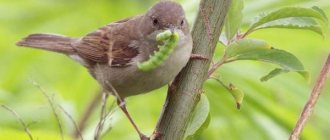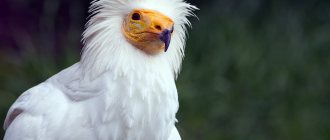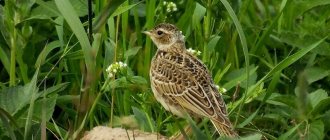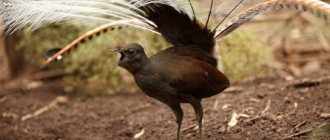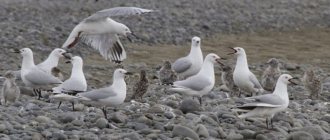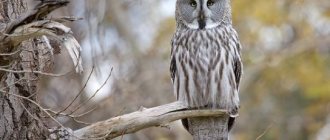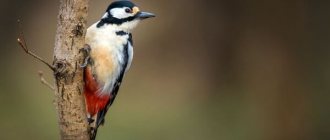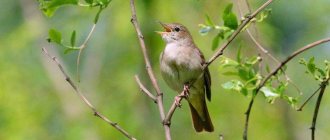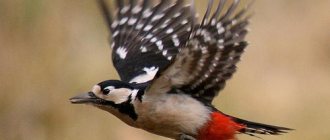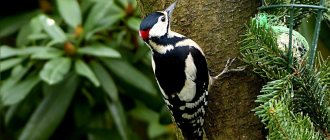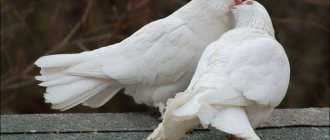Zhelna or black woodpecker
(lat. Dryocopus martius) is a bird that belongs to the order Woodpeckers, the woodpecker family. Zhelna is slightly larger than the jackdaw, its body length varies from 420 to 486 mm. The wingspan of a woodpecker representative ranges from 715 to 800 mm. This species is in the Red Book of Kursk and Lipetsk regions, North Ossetia. Representatives of the species are not protected in any way.
WHAT DOES IT EAT?
Zhelna feeds mainly on ants. The bird prefers large red-breasted carpenter ants, but does not disdain other species, for which it often descends to the ground. In addition to ants, the diet of the great black woodpecker includes various insects, their larvae and pupae. On living and dead trees, the yellowtail looks for beetles, which it takes out from under the bark with its long beak. In search of food, the black woodpecker rakes the turf and tears the bark from dead trees. The bird visits anthills and catches insects with its sticky tongue. Zhelna loves large ants so much that she can spend hours digging in an anthill, removing from it not only ants, but also their larvae. Having found a tree that is very damaged by some larvae, the woodpecker knocks off the bark from it with blows of its beak and pulls out the insects. In some regions, the gal's diet consists of 99 percent ants. In other areas, the woodpecker's menu includes, along with ants, the larvae of butterflies and other flying insects. In winter, it gives preference to ants and bees, removing them from their shelters.
Black woodpecker in the Red Book
In the latest edition of the Book for 2011, the black woodpecker was classified as a second category of rarity. This is a species whose distribution has declined significantly. For some time, under unfavorable conditions, it may be endangered in the park and forest areas of Moscow.
Zhelna is protected in North Ossetia, Kursk and Lipetsk regions. In some regions of Russia it is also included in the Red Book. The destruction of a forest orderly is punishable at the legislative level.
Zhelna is listed in the Red Book of Moscow.
Main causes of extinction
The population of this species is facing extinction due to human activity. In recent years, there has been active cutting down of old trees, where the habitat of black woodpeckers is usually located.
It is in old, diseased trees that birds find food for themselves in the form of various larvae that hide under the bark. Current population situation
Zhelna is a common, scarce species throughout its range. The number ranges from 210 to 265.5 thousand pairs. Nesting density is:
- in mixed and deciduous forests of Karelia 0.2 pairs per 1 km2;
- in the Middle Urals in spruce-fir forests there are 2 pairs per 1 km2;
- in the Far East 1.1 pairs per 1 km2.
In Western Europe, there is an increase in birds in many countries:
- France – 1,000 pairs;
- Belgium – 275 pairs;
- Netherlands - 2,500 pairs (in 1950 there were only 100 pairs);
- Sweden – 50,000 pairs;
- Finland – 15,000 pairs.
A population decline has been observed in Italy.
Do you need to take protective measures?
Zhelna is considered a forest orderly. It needs to be protected and the population increased. It is imperative to observe the ban on shooting black woodpeckers.
To do this, you need to properly clean forests and parks. It is rational to carry out the construction of industrial facilities in the forest zone. To preserve the population, it is necessary to promote its conservation.
REPRODUCTION
Adult squirrels stay solitary. In March, when the mating season of black woodpeckers begins, the male attracts the attention of the female by knocking with his beak on dry twigs that vibrate well. The call of the males - a loud “fru-fru-fru” - is heard throughout the forest at a great distance. Less commonly, males make a “keee” sound, reminiscent of a purr. After pairing, black woodpeckers can be observed flying from tree to tree and chasing each other on the tree trunk, moving in a spiral. The birds fly one by one and drum on the tree, then “bow.” Males, when meeting with irritation, nod their heads and threaten each other with their beaks. The male female invites his chosen one to his “estate.” Here the female examines the hollows and chooses the most convenient one. If the hollow is unfinished, the birds get to work together.
Zhelny usually hollow out several hollows in which they alternately sleep. In 3-4 weeks, the woodpecker hollows out a hollow up to 40 cm deep and up to 22 cm wide. After the construction of the nest is completed, the woodpeckers mate, and soon the female lays 2-6 eggs. Parents incubate the clutch alternately, changing approximately every 2 hours. Since incubation does not last long, the chicks are born rather weak: each of them weighs only 9 g. At first, feeding the helpless chicks is not easy for parents, and after 10 days the chicks energetically demand food. Parents take care of the chicks after they leave the nest for quite a long time.
Continuation of the family line
You can find out that the mating season has begun by the characteristic sounds in the forest. When you hit it in early February, you can hear fractional blows, as if they were hitting a fence with a stick. This is how they announce the beginning of the mating season for this species.
Males organize a kind of hunt, chasing both females and their competitors. They encourage ladies to create a pair, and drive other males away from a potential partner. There are no battles between them as such, but they create a lot of noise during the racing.
Pairs are formed only in March-April; in this composition they will live for at least 1 season. Pairs occupy a fairly large area of the forest; a tall, smooth tree is selected from it. Most often the choice falls on:
- Aspen.
- Pine.
- Spruce.
- Birch.
Considering their feeding habits, it becomes clear that the pair will look for a diseased tree, and may even nest on a dry one.
Moreover, it is interesting that the female will never choose last year’s shelter, because she loves to hollow out a new hollow every year. They are not even stopped by the large labor costs, because they make several hollows on one tree. If there are unoccupied shelters nearby, they are used as a place to rest.
The hollow in which the nest will be built is located high - 3-15 meters from the ground. The tap hole is in the shape of an ellipse, the height is no more than 15 cm, the width is 10. There is no bedding at the bottom, and the recess relative to the tap hole is from 40 to 60 cm. For softening, wood chips are used, which are formed after construction.
The clutch is created in April-May, it contains 4-5 eggs, they are not laid on the same day. Interestingly, the incubation stage occurs even before the clutch becomes full-fledged. Warming the future offspring is entrusted to both the female and the male; they do this in turn.
The maturation of the young occurs quickly; after 2 weeks they hatch, and the first chick to emerge is often the largest. In black woodpeckers, small individuals are not killed by larger ones, but the latter are still more likely to survive. The babies eat every 15-20 minutes and leave the nest after 20-25 days.
Lifespan in wildlife is about 7 years.
Black woodpecker with chicks
WHERE DOES IT LIVE?
Zhelny, or black woodpeckers, live in almost all forests of Europe and Asia. They inhabit both deciduous and coniferous forests, as well as mixed forests, with a particular preference for untouched, extensive open forests. Everywhere they stay in areas covered with old tall forests. Very often these woodpeckers are found in areas of former forest fires.
Woodpeckers usually nest in beech forests and pine forests, but their hollows can also be seen in the trunks of spruce, juniper and larch trees. If there are trees suitable for making nests, yellowtails nest even in parks. These shy and very cautious birds are frightened by the slightest rustling sound. They rarely nest near human habitations.
The presence of a black woodpecker is evidenced from afar by the audible frequent knocking on a dry branch, as well as its loud sounds. Zhelna can be heard more often than seen. The black woodpecker deftly climbs tree trunks, clinging to the bark with strong claws - they especially help the bird when searching for food.
When hollowing out a hollow and hunting for insects, the black woodpecker holds on to the bark with its claws and leans on its stiff tail. Looking for food, the woodpecker constantly flies from one tree to another, while emitting characteristic cries.
Voice
This bird is noisy during the nesting period. During the flight, this representative of the woodpeckers makes a “tyr-tyr-tyr” sound. When landing on a perch, he shouts “k-ya-ya-ya.” During the mating season, the sound of “clay-clay” is heard. Before mating begins, individuals seem to meow. There are also other types of sounds. A common form of behavior is creating depressions in tree trunks. In spring these birds may drum.
INTERESTING FACTS, INFORMATION…
- Zhelna drinks the rainwater that accumulates in the depressions on the bark of old trees and in their hollows.
- The black woodpecker was observed in the mountains of Tibet at an altitude of 4000 m above sea level.
- An adult woodpecker has no down under its feathers. The feathers of this woodpecker are very stiff, pointed at the ends. The rigid tail creates reliable support while hollowing out the hollow. The tiled spine of the individual integumentary feathers is also rigid.
- The nostrils of most species of woodpeckers are covered with tufts of feathers, which creates protection against wood dust and dust getting inside.
- The yellowtail, compared to other birds, has very tough skin, which protects the bird from insect bites, in particular carpenter ants, which it mainly feeds on.
- Zhelna usually spends from 10 to 17 days hollowing out a hollow.
- At the end of the long tongue, the yellow tongue has 4-5 pairs of needle-shaped taste buds. It is to them that insects stick. Thus, the woodpecker extracts them from holes in the bark.
Lifestyle, nutrition
The bird migrates but does not fly long distances. He can build his hollows all day long. Since it takes her about two weeks. Almost all the arboreal living space in the forest is her work.
The antics of the black woodpecker photo.
The woodpecker chooses fairly tall trees and feeds on insects, longhorned beetles, caterpillar pupae, and ants. Hollowing out about 450 pieces per day. You can even see a tree completely without bark.
The woodpecker eats prey with its tongue, which protrudes 5 cm beyond the beak. The woodpecker is moistened with a sticky secretion, and there are also taste buds on it, which help to quickly catch lunch.
The bird loves to sing, trilling or drumming, during the breeding season. For the winter it migrates a little further from the nesting site. Leads a daytime life, and at night rushes to his house.
DESCRIPTION OF THE JELLY
Adult bird: the size of a crow; The plumage is black, the eyes and beak are lighter. The male has a red top of the head, and the female has a red nape.
Hollow: located at a height of 7-15 m from the ground, spacious, with a characteristic oval or rectangular hole.
— Habitat
WHERE DOES IT LIVE?
Zhelna lives everywhere in Eurasia: from northern Spain and the Scandinavian Peninsula to Japan.
PROTECTION AND PRESERVATION
Zhelna is very timid and cautious. Preference is given not to coniferous, but to deciduous forests. The bird is distributed throughout its entire range.
Subspecies
In this species, variation in plumage color is not observed. In northern Eurasia, the size of individuals increases from west to east. There are 2 subspecies; only one lives in the countries of the former Soviet Union - Dryocopus martius martius. The color of the plumage is slightly duller than that of the isolated subspecies that inhabits eastern Tibet - D. m. Khamensis.
Black Woodpecker Dryocopus martius. Video (00:00:46)
Black Woodpecker. Our largest woodpecker is the black woodpecker (Dryocopus martius). The bird's amusing appearance is complemented by its manner of peeking out from behind a tree (with such a long neck this is not difficult). Women are characterized by developed vocal communication. His voice is very harsh. In flight, the yellowtail emits an uneven trill, and when sitting on a tree, it makes long-drawn cries. The woman's voice can be heard almost all year round. In the spring, during the current period, this 'song' accompanies the drumming. During the incubation of eggs, the male and female exchange vocal signals, replacing each other in the nest. When feeding the chicks, the parents announce their approach from afar, and the hungry offspring respond to them with a deafening din. By nature, Zhelna is a loner. It lives mainly in old mixed or coniferous forests. On its territory, the zhelna has up to a dozen hollows, but at the same time actively uses 2-3. Most often, aspen is chosen for the hollow, and pine is somewhat less common. Usually the hollow is located at a height of 10-20 m above the ground, but sometimes it can be at a height of 3 m. The hollow of the yellow woodpecker is easily distinguished from the hollows of other woodpeckers by its shape and size: it is oval, 10 centimeters wide and 15 centimeters high, the depth of the hollow - up to half a meter. Ants play a significant role in the black woodpecker's diet. It also feeds its chicks almost exclusively with ants. Another notable component of its menu is various bark beetles, lumberjacks, borers, longhorned beetles, horntails and other wood-dwelling forest pests. In search of these insects, the zhelna crushes old rotten stumps, clears bark and crushes dry trees infested with pests. As the largest and strongest woodpecker, it can reach insects that others cannot reach. And it feeds on insects all year round, only slightly diversifying its table with berries. The lek's current begins in early spring. Already in early to mid-April you can hear the characteristic drumming (almost 20 beats per second!) and screams. Both males and females knock and scream. There is no bedding in the hollow; the bottom is covered only with wood chips, on which the female lays 3-5 white eggs. Incubation lasts very little even for woodpeckers - 12-13 days. The chicks live in the hollow for about a month and for about another month after leaving the nest (somewhere in mid-June) they stay with their parents. Both parents incubate and feed the chicks. Protvino Moscow region Russia
Lifestyle and habitat
The woodpecker is a sedentary bird. Lives in forests of all types: coniferous, mixed, broad-leaved. Woodpeckers live alone or in pairs; they do not form groups or flocks. For feeding, choose an area with old trees and rotten trunks. The size of a forest plot capable of feeding a pair of woodpeckers is at least 3-4 square meters. km.
Zhelna usually stays away from human habitation. If a city or town is surrounded by old parks, a pair of woodpeckers may settle in them. Another habitat for black woodpeckers associated with humans is old clearings. Trees and stumps remaining in cleared areas are often infested with bark beetles—food for woodpeckers.
Like all birds, they molt when they are born. This happens at the end of summer, when caring for the new generation of black woodpeckers ends. Birds molt gradually, first the large flight feathers change, then the tail feathers. In autumn the turn comes to small feathers.
In the territory where the chicks were hatched and fed, two woodpeckers may feel crowded and there may not be enough food. In this case, birds that have survived the change of feathers begin to search for new feeding areas. In addition to flat areas, the yellowtail often chooses high-mountain forests for life. The black woodpecker can be seen and heard at altitudes of up to 4000 m.
Life in a new territory begins with the construction of a hollow shelter. During the year, the bird hollows out several shelters in the trunks. Zhelna in the photo is most often captured next to the hollow. The shelter created in the spring becomes a nest, the rest are used for night rest.
Black woodpeckers do not have many natural enemies. Of the terrestrial predators, martens reach the nests of black woodpeckers more often than others. They can steal eggs and chicks. After robbery, the marten can take over the village's house.
In addition to martens, representatives of corvids can act as nest destroyers: crows, magpies. In the Far East, the Ussuri snake reaches woodpecker nests. Not all birds of prey manage to hunt in the forest. Threats to black woodpeckers include great owls, great eagle owls, goshawks, buzzards, and golden eagles.
In addition to ground and feathered enemies, birds are attacked by small parasites of all varieties. These are bloodsucking flies, fleas, springtails, ticks and others. Not a single woman has been able to avoid intestinal parasites. The isolated life in the forest helps woodpeckers cope with carriers of infection and parasites.
The main threat to the species is industrial construction and massive clear-cutting of forests. This deprives woodpeckers not so much of food as of nesting sites. Black woodpeckers are not very rare, but they are sensitive birds to changes in their habitat.
The influence of black woodpeckers on the life of the forest and forest inhabitants is beneficial. Xylophagous insects are destroyed methodically and in large numbers. A bird's nest , which has fulfilled its purpose and is abandoned by a bird, serves as a home for a wide variety of birds and animals. For crowed owls and owls, woodpecker hollows are almost the only shelters suitable for nesting.
Common types
Great spotted woodpecker (Dendrocopos canicapillus)
The photo shows a great sharp-winged woodpecker.
A small bird with a long, straight beak. Body length is from 14 to 16 cm. Body weight ranges from 20 to 30 g. The plumage is motley, black and white above and whitish-gray below. At the bottom of the back there is a light diamond-shaped spot. The forehead and crown are brownish-gray, the back of the head is black. The male has red feathers on the back of his head. Dark “whiskers” begin from the beak. The cheeks and throat are white. The back is dark. The belly is whitish-gray with dark streaks. The iris is red-brown or red, the legs and beak are dark gray. Juveniles are darker and motley. Females do not have red feathers on the back of their heads, but otherwise they do not differ from the male.
The species is distributed in eastern and southeastern Asia.
Brown-fronted Woodpecker (Leiopicus auriceps)
This is what a brown-fronted woodpecker looks like
. A medium-sized woodpecker that lives in the foothills and lower belt of the Himalayas (Afghanistan, Pakistan, India and Nepal).
The body length reaches 20 cm, weight from 37 to 50 g. The beak is of medium length, chisel-like, with a wide base. The plumage on the back and wings is motley, black and white, the belly is light, the “cap” is colorful. The forehead is yellowish-brown in both males and females. But the male has a lemon-yellow crown and the back of the head is red, while the female has both the crown and the back of the head yellow. The cheeks and chin are white with a black mustache. The chest and belly are white with dark streaks.
Yellow-breasted Woodpecker (Dendrocopos macei)
Photo of a yellow-breasted woodpecker on a tree.
The species' habitat includes countries such as Bhutan, Bangladesh, Cambodia, India, Indonesia, Laos, Myanmar, Nepal, Pakistan, Thailand and Vietnam.
Medium sized woodpecker. The plumage on the back is black with white transverse stripes. The breast is light brown. Neck with black stripes on each side. Males have a red head with an orange forehead, females have a black head.
Spotted Woodpecker (Dendrocopos atratus)
Photo of a spotted woodpecker
A small bird with a dense build, a resident of Indochina. Body length up to 22 cm, weight from 42 to 52 g. The back and wings are black with a white spotted pattern. The neck is whitish, the breast and belly are yellowish-ochre in color with thin longitudinal black streaks. The undertail is red. The sides of the head are white with a black stripe of “whiskers”. The male has a bright red cap of feathers running from his forehead to the back of his head. The female's is black.
Yellow-capped woodpecker (Dendrocopos mahrattensis)
The species is widespread in Hindustan and Indochina. This is a small bird with a long straight beak. Body length is about 18 cm, weight from 28 to 46 g. The plumage in the forehead and crown is golden yellow. The nape of the male is bright red, while that of the female is brownish-ochre. The “whiskers” are weakly expressed. The cheeks, chin and throat are white with brown spots. The body at the top is black or black-brown with white spots and streaks, the lower back is white. The belly is white with an orange-red spot in the center. Young birds are feathered brown.
Red-bellied or red-necked or red-breasted woodpecker (lat. Dendrocopos hyperythrus)
Body length from 20 to 25 cm, weight from 53 to 74 g. The beak is long. The male's back is black with white transverse stripes, his belly is reddish-chestnut. The female has a brown back. Males have a shiny red cap on their heads, while females have a black cap with white spots. The legs are gray, the iris is red.
The habitat begins in the Himalayas from Kashmir to Assam. The bird is also found in China, Vietnam and Thailand.
Middle Spotted Woodpecker
- Latin name: Leiopicus medius, Dendrocopos medius
- Body length: 22 cm.
- Weight: from 50 to 85 g.
- Order: Woodpeckers
- Family: Woodpeckers
- Genus: Spotted Woodpeckers
- Conservation status : Least Concern
The head is rounded, the beak is short, dark gray. The upperparts are black with white streaks on the wings. The belly and sides are yellowish with dark longitudinal streaks. The iris is red-brown, the paws are gray. The “whiskers” are weakly expressed. There is a bright red cap on the crown. Young birds are dull.
The species nests in temperate and southern latitudes of Europe, as well as in Western Asia. Habitat: broad-leaved, mixed forests, most often dominated by oak.
Photo: Middle Spotted Woodpecker
The Middle Spotted Woodpecker is similar to the Great Spotted Woodpecker, but if you look closely the two birds are noticeably different from each other. The color of the average spotted woodpecker is not as bright as that of the great one. It knocks less, in the summer it spends most of its time in the crown of trees and practically does not fall to the ground.
White-backed Woodpecker (Dendrocopos leucotos)
Body length is from 26 to 31 cm, wingspan is 44-49 cm, body weight is from 100 to 130 g. The male has a white forehead and sides of the head, a red “cap” with white spots, the back of the head and back are black. The mustache is black. The belly is white, with an ocher coating; sides with dark longitudinal streaks. The undertail is pink. The female has a black cap on her head.
The bird lives in the south of Eurasia.
Great Spotted Woodpecker
- Latin name: Dendrocopos major
- Body length: 22-27 cm.
- Wingspan: 42-47 cm.
- Weight: 60-100 g.
- Order: Woodpeckers
- Family: Woodpeckers
- Genus: Spotted Woodpeckers
- Conservation status : Least Concern
Body length is from 22 to 27 cm, wingspan is 42-47 cm, weight is from 60 to 100 g. The plumage is dominated by black and white tones, the undertail is bright red. The top of the head, back and rump are black. The forehead, cheeks, shoulders and tummy are brownish-white. The tail is black. The iris is brown or red, the beak is black, the legs are dark brown.
The species is found in Africa, Europe and Asia Minor.
Syrian woodpecker (Dendrocopos syriacus)
The bird's habitat covers Asia, Central and Eastern Europe.
Body length up to 23 cm, weight from 55 to 80 g. The top of the head is black, the forehead, sides of the head and cheeks are white. The male has a bright red stripe on the back of his head; the female does not have it. The "whiskers" are well developed. The throat, neck and belly are off-white. The undertail is red. The iris is red. The beak is dark gray. Paws are gray.
White-winged Woodpecker (Dendrocopos leucopterus)
The species is found in Central Asia, Dzungaria and Kashgaria.
Body length from 22 to 24 cm, weight about 70 g. Beak of medium length, straight. There are large white spots on the shoulder blades and wings, the belly and undertail are bright red. The forehead is white.
Lifestyle
Woodpeckers prefer a sedentary lifestyle and always hide between the branches. And all because, due to their body structure, they are very unstable on planes. These birds even sleep in an upright position.
Woodpecker habitats
Due to their enormous species diversity, woodpeckers are found everywhere from Siberia to Africa. There are none except in Scandinavia and the Arctic. They prefer to live on the upper levels of forests, but are not afraid of being close to humans; they willingly settle near houses and feed on waste.
Photo: fotokto.ru
Diet
The vast majority of woodpeckers feed on parasites and insects that live on tree bark. They destroy bark beetles, aphids, termites and ants, and that is why they are nicknamed forest orderlies. By the way, woodpeckers find trees with a breeding ground for pests by hearing. And in winter, birds switch to plant foods - pine cones, nuts, seeds.
Photo: hvorast.ru
Wintering
Almost all woodpeckers are sedentary birds, not prone to migration. They can move only when the food supply is depleted. They hide from frost in pre-prepared hollows. And only a few representatives fly away to spend the winter in the warmth of the coldest regions.
Photo: proprikol.ru
Captivity
Woodpeckers are very rarely kept in captivity. But not even because it is hard for the bird, but because it becomes unbearable for the potential owner. For days on end, the woodpecker knocks on the bars of the cage, and in addition to the constant noise, over time, problems with a broken beak are added.
Photo: faunazoo.ru
Swift (50 photos): description of the bird, what it eats and where it lives
